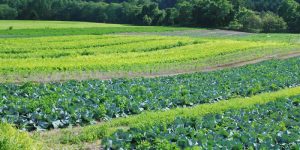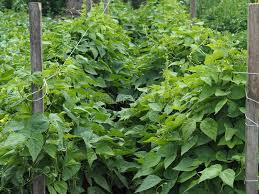CROP ROTATION- CHOICE & BENEFITS
INTRODUCTION
Crop Rotation the practice of growing different type of crops in a specific order on the same piece of land in sequenced season. It is adjusted so that the soil of farms is not used for only one set of nutrients. The rotation of crops thus helps in reducing soil erosion and increases soil fertility and crop yield.
Growing the same crop on the same piece of land for many years in succession gradually depletes the soil of certain nutrients. With rotation, a crop that leaches the soil of one kind of nutrient is followed during the next growing season by a dissimilar crop that returns that nutrient to the soil or draws a different ratio of nutrients.
In addition, crop rotation mitigates the buildup of pathogens and pests that often occur when one species is continuously cropped, and can also improve soil structure and fertility by increasing biomass from varied root pattern.

CHOICE OF CROPS IN ROTATION
The choice of crop is related to the goal of farmers for which they adopt rotation. Therefore, it may be weed management, insect-pest control, increase nitrogen status in the soil, and prevent soil erosion or increase biomass etc. Here some crop types used in rotation are described below-
- Legume Crops– Legumes are essential in any crop rotation and should comprise 30-50% of the crop land. Legumes like alfalfa, clover etc. collect available nitrogen from the soil in nodules on their root structure. When the plant is harvested, the biomass of uncollected roots breaks down, making the stored nitrogen available to subsequent crops. In addition, legumes have heavy tap roots that burrow deep into the ground, lifting soil for better tilth and absorption of water.

Legume crop - Grasses & Cereals- Cereal and grasses are frequent cover crops and supply to soil quality and structure. The dense and far-reaching root systems give ample structure to surrounding soil and provide significant biomass for soil organic matter. Grasses and cereals are key in weed management as they compete with undesired plants for soil space and nutrients.
- Green Manure- is a crop that is mixed into the soil and increase soil fertility. Both nitrogen-fixing legumes and nutrient scavengers, like grasses, can be used as green manure. Green manure of legumes is an excellent source of nitrogen, especially for organic systems; however, legume biomass does not contribute to lasting soil organic matter like grasses do.
- Row Crops- Row crops typically have low biomass and shallow root system; this means the plant contributes low residue to the surrounding soil and has limited effects on soil structure. With much of the soil around the plant exposed to disruption by rainfall and traffic, fields with row crops experience faster break down of organic matter by microbes, leaving fewer nutrients for future plants. Vegetables are the examples of row crops.
Crop rotation systems may be enriched by the influences of other practices such as the addition of livestock and manure, intercropping or multiple cropping, and organic management that is important for sustainable agriculture.
Advantages of Crop Rotation
Crop rotation has many benefits; however it depends mainly on the goal of farmers. Some of the benefits are as follows:
- Nitrogen Fixing– Legumes have nodules on their roots which contain nitrogen fixing bacteria i.e. rhizobia. During a process called nodulation, the rhizobia bacteria use nutrients and water provided by the plant to convert atmospheric nitrogen into ammonia, which is then converted into an organic compound that the plant can use as its nitrogen source.
When a farmer plants leguminous crops, legumes together with these nitrogen-fixing bacteria enrich soils with the “fixed” type of nitrogen. For example Soybeans can fix up to 200 kg of nitrogen per hectare in one year. - Insect-pest Control- Crop rotation is also used to control pests and diseases that can become established in the soil over time. The changing of crops in a sequence decreases the population level of pests by interrupting pest life cycles and interrupting pest habitat.
Plants within the same family tend to have similar pests and pathogens. By regularly changing crops and keeping the soil occupied by cover crops instead of lying fallow, pest cycles can be checked or limited, especially cycles that benefit from overwintering in residue. - Weed Management- By including cover crops into crop rotations is of particular value to weed management. These crops crowd out weed through competition.
In addition, the compost from cover crops and green manure slows the growth of what weeds are still able to make it through the soil, giving the crops further competitive advantage.
By slowing the growth and proliferation of weeds while cover crops are cultivated, farmers greatly reduce the presence of weeds for future crops, including shallow rooted and row crops, which are less resistant to weeds. Cover crops are, therefore, considered conservation crops because they protect otherwise fallow land from becoming overrun with weeds. - Prevent Soil Erosion & Improve soil structure– Crop rotation can significantly reduce the amount of soil lost from erosion by water. In areas that are highly susceptible to erosion, farm management practices such as zero and reduced tillage can be supplemented with specific crop rotation methods to reduce raindrop impact, sediment detachment, sediment transport, surface runoff, and soil loss.
Protection against soil loss is maximized with rotation methods that leave the greatest mass of crop stubble (plant residue left after harvest) on top of the soil. Stubble cover in contact with the soil minimizes erosion from water by reducing overland flow velocity, stream power, and thus the ability of the water to detach and transport sediment.
When a forage crop breaks down, binding products are formed that act like an adhesive on the soil, which makes particles stick together, and form aggregates that is important for erosion control, as they are better able to resist raindrop impact, and water erosion.
In regions, where climate conditions are less predictable and unexpected periods of rain and drought may occur, a more flexible approach for soil cover by crop rotation is necessary. An opportunity cropping system promotes adequate soil cover under these erratic climate conditions.
When rotating crops on the same land, soil structure improves because we alternate between deep and shallow rooted plants. For example, oats have large and deep reaching root system, while red clover has small and shallow roots. By planting these plants subsequently, their different root systems improve soil structure by increasing soil porosity, Stabilizing soil particle aggregates, Improving nutrient management by plants e.g. oats draw nutrients from the deeper soil layers, while clover draws nutrients from the upper layer. Increasing water retention in soils Providing habitat for more diverse soil organisms Supplying higher content of organic matter. - Crop Yield- Crop rotation contributes to increased yields through improved soil nutrition. By requiring planting and harvesting of different crops at different times, more land can be farmed with the same amount of machinery and labor.
Read more…..
SUBSISTENCE FARMING-HISTORY & TYPES,
WHAT IS SOIL EROSION- TYPES & MECHANISM,
DIFFERENCE BETWEEN CLIMATE & WEATHER
AGRICULTURE IN INDIA: Development & Present Scenario
GREEN REVOLUTION IN INDIA- ITS IMPACT
CROPPING PATTERN-CROPPING SYSTEM
TYPES OF FARMERS-GOVERNMENT INITIATIVES
FORMATION OF SOIL-PROCESS & FACTOR OF SOIL FORMATION
SOIL TYPES IN INDIA: FEATURES
INTEGRATED FARMING SYSTEM
MULCHING MEANING- TYPES & USAGE
very nice bhaiya
Thanks Rahul.you may refer to other student who want reading materials.